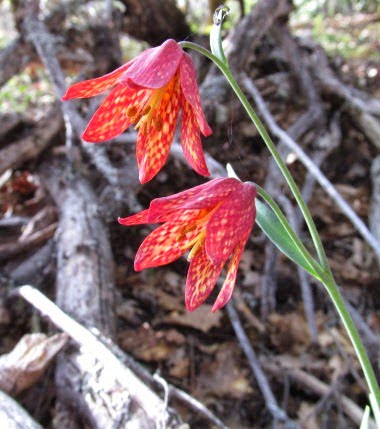
Finding Fritillary
 |
| Fritillaria gentneri (Gentner’s fritillary) Photo credit: Scott Orr |
The 2014 field season kicked-off last week with a trip down to Grants Pass, OR. Our mission was to monitor an endangered population of Fritillaria gentneri (Gentner’s fritillary). F. gentneri is endemic to a small portion of Southern Oregon and Northern California with the largest number of individuals occurring in Jackson County, OR. The Institute for Applied Ecology began their study of this Southern Oregon population in 2002. By gathering a demographic baseline for F. gentneri, we can assist in long-term efforts to examine this sub-population’s response to climate and habitat change. This particular area near Grants Pass has even been nominated as an ACEC (Area of Critical Environmental Concern) by the Bureau of Land Management (BLM) due to the large F. gentneri population and the long-term data set that can inform management decisions.
| Hiking down to our study site, Pictured from left: Tara Callaway, Amy Comstock and Bryan Wender Photo credit: Emma MacDonald |
As we pulled up to our first site and stepped out of Keith (our lovingly named work van), we noticed two things: steep, rocky slopes and Toxicodendron diversilobum (poison oak). We quickly suited up in protective gear, loaded up our packs, and began our scramble upward in search of the rare crimson flower. Our study site was located on a south-facing slope, just north of Picket Creek, where one of the largest known F. gentneri sub-populations remains. Although the dark crimson color of its bell shaped flower is a distinguishing feature, it can be quite difficult to tell apart from its close relatives, F. affinis and F. recurva, and difficult to spot on the hillside. Additionally, the majority of individuals never produce a flowering stalk and remain in the vegetative state as inconspicuous single leaves, rarely growing wider than 4 centimeters. Vegetative F. gentneri commonly propagate asexually via offset bulb growth, resulting in low genetic diversity within small sub-populations.
| Laying out density transects, Pictured: Emma MacDonald Photo credit: Scott Orr |
| Delphinium menziesii (purple larkspur) Photo credit: Emma MacDonald |
Despite copious amounts of Poison oak, 45+ degree slopes, and the blazing sun, we had a wonderful time!